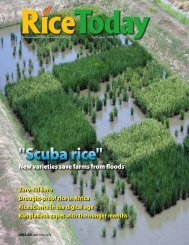<strong>How</strong> <strong>much</strong> <strong>water</strong><strong>does</strong> <strong>rice</strong> use?by Bas BoumanRice Today examines this often-asked(and often poorly answered) questionJose Raymond PanaliganMany people ask thequestion, “<strong>How</strong> <strong>much</strong><strong>water</strong> <strong>does</strong> it take toproduce 1 kg of <strong>rice</strong>?”The answer to this question lies inthe definition of “<strong>water</strong> use” and of“<strong>rice</strong>.” We can identify three types of<strong>water</strong> “use”—through transpiration,evaporation, and a combinationof seepage and percolation—at,respectively, three scales of <strong>rice</strong>—theplant, the crop, and the field.The <strong>rice</strong> plant “uses” <strong>water</strong>through the process of transpiration,which cools the plant and drivesthe upward sap flow—which carriesessentialnutrients—fromroots to leaves.This is a “real”<strong>water</strong> use, sinceonce the plant hastaken up <strong>water</strong>and released it tothe atmospherethroughtranspiration,that amountof <strong>water</strong> is nolonger availablefor reuse by thatsame plant inthe same growthcycle. Transpired<strong>water</strong> enters theSOglobal <strong>water</strong> cycle and will eventuallyreturn to the earth as rain or snow.The <strong>rice</strong> crop comprisesthe plants and underlying soil.Besides transpiration from theplants, <strong>water</strong> leaves the cropfrom the soil underneath throughevaporation. Like transpiration,evaporated <strong>water</strong> is “lost” andcannot be used again by that samecrop in the same growth cycle. Thiscombined <strong>water</strong> use by a <strong>rice</strong> cropis called “evapotranspiration.”In <strong>rice</strong> fields, <strong>water</strong> is oftenponded to ensure there is plentyfor the crop to take up. BesidesPlow layerI R TPuddledsoilSubsurface soilevapotranspiration, outflows of<strong>water</strong> from a field occur throughseepage and percolation: sidewardand downward <strong>water</strong> flows throughthe soil and bunds out of the field.For an individual farmer, these arereal losses as well, and she considersthe total combined outflows byevapotranspiration, seepage, andpercolation as <strong>water</strong> use by her <strong>rice</strong>field (see figure). The farmer <strong>need</strong>sto ensure sufficient irrigation (tocomplement rain<strong>water</strong> if rainfallis insufficient) to match all theseoutflows. At a larger spatial scale,however, seepage and percolationFlood<strong>water</strong>CPEBundSOGround<strong>water</strong>Water balance of a puddled <strong>rice</strong> field: C = capillary rise; E = evaporation; I = irrigation; O = over-bund flow; P = percolation; R = rainfall;S = seepage; T = transpiration.28 Rice Today January-March 2009
flows from one field enter theground<strong>water</strong> or creeks and drains,from where other farmers mayreuse the <strong>water</strong> to irrigate otherfields. This is in contrast to the<strong>water</strong> losses by evapotranspiration,which cannot be recaptured.Rice plant <strong>water</strong> use(by transpiration)Pot experiments and greenhousestudies carried out at theInternational Rice ResearchInstitute (IRRI) have shown that<strong>rice</strong> plants growing under a rangeof <strong>water</strong> applications transpired500–1,000 liters of <strong>water</strong> to produce1 kg of rough (unmilled) <strong>rice</strong>. 1 Thisis at the high end of comparablecereals such as wheat and barley.Rice crop <strong>water</strong> use (byevapotranspiration)The estimated <strong>water</strong> use byevapotranspiration of all <strong>rice</strong> fieldsin the world is some 859 cubickilometers per year. 2 With a globalrough <strong>rice</strong> production of around600 million tons, it takes an averageof 1,432 liters of evapotranspired<strong>water</strong> to produce 1 kg of rough<strong>rice</strong>. This is roughly the same asthe world-average <strong>water</strong> use ofwheat, but higher than that ofmaize and barley (see Table 1).The variability in <strong>water</strong> useTable 1. World-average <strong>water</strong> use by evapotranspiration of majornon<strong>rice</strong> grain crops (liters of <strong>water</strong> per kg of grain).Source Wheat Maize BarleyFalkenmark and Rockström, 2004 3 1,480 1,150 1,000Chapagain and Hoekstra, 2004 4 1,300 900 –Table 2. Liters of evapotranspired <strong>water</strong> <strong>need</strong>ed to produce 1 kg ofrough <strong>rice</strong>.Source Minimum Medium MaximumZwart and Bastiaansen, 2004 5 625 909 1,667Table 3. Total global <strong>water</strong> use (cubic kilometers of<strong>water</strong> per year).Source Chapagain Falkenmark andand Hoekstra, Rockström, 2004 32004 4Total 7,450 8,160Food 6,390 7,200Industry 716 780Domestic 344 180by evapotranspiration by <strong>rice</strong>crops is large. Table 2 summarizesexperimental data from wellmanagedlowland field experimentswith <strong>rice</strong>.By comparison with total global<strong>water</strong> use, Table 3 puts the world<strong>rice</strong> <strong>water</strong> use by evapotranspirationinto perspective. Producing theworld’s <strong>rice</strong> accounts for 12–13%of the amount of evapotranspired<strong>water</strong> used to produce all of theworld’s food (food crops andgrass and fodder for livestock).Rice field <strong>water</strong> use (to accountfor evapotranspiration plusseepage and percolation)On average, about 2,500 litersof <strong>water</strong> <strong>need</strong> to be supplied (byrainfall and/or irrigation) to a <strong>rice</strong>field to produce 1 kg of rough <strong>rice</strong>.These 2,500 liters account for allthe outflows of evapotranspiration,seepage, and percolation. Thisaverage number is derived froma large number ofexperimental data atthe individual fieldlevel across Asia.Variability is large,ranging from around800 liters to morethan 5,000 liters. Thisvariability is causedby crop management(such as varietyplanted, fertilizationregime used, and pest and diseasecontrols adopted), weather, andsoil properties. At the field level,<strong>water</strong> inputs to <strong>rice</strong> fields are 2–3times those of other major cereals.Although <strong>rice</strong>’s <strong>water</strong> productivityin terms of evapotranspirationis similar to that of comparablecereals such as wheat, <strong>rice</strong> requiresmore <strong>water</strong> at the field level thanother grain crops because of highoutflows—in the forms of seepageand percolation—from the field.<strong>How</strong>ever, because these outflowscan often be captured and reuseddownstream, <strong>rice</strong>’s <strong>water</strong>-useefficiency at the level of irrigationsystems (which comprise many fields)may be higher than that at the fieldlevel. Nevertheless, around onequarterto one-third of the world’sdeveloped fresh<strong>water</strong> resources areused to irrigate <strong>rice</strong> (which, it mustbe remembered, is the staple food foralmost half the world’s population).Rice production must be viewedin the light of the emerging <strong>water</strong>crisis, as climate-change-inducedshifts in rainfall patterns combinewith the diversion of irrigation <strong>water</strong>for urban and industrial uses. Asagricultural <strong>water</strong> scarcity increases,there is a growing <strong>need</strong> for <strong>water</strong>savingtechnologies such as aerobic<strong>rice</strong> (varieties that grow well inunflooded fields; see High and dryon pages 28-33 of Rice Today Vol. 6,No. 4) and more efficient irrigationregimes such as alternate wetting anddrying (see The big squeeze on pages26-31 of Rice Today Vol. 7, No. 2).Dr. Bouman is a senior <strong>water</strong>scientist and head of the Crop andEnvironmental Sciences Division atIRRI.1Haefele SM, Siopongco JDLC, Boling AA, Bouman BAM, Tuong TP. 2008. Transpiration efficiency of <strong>rice</strong> (Oryza sativa L.). Field Crops Research.(In press.)2Mom R. 2007. A high spatial resolution analysis of the <strong>water</strong> footprint of global <strong>rice</strong> consumption. Master thesis, University of Twente, Enschede,Netherlands.3Falkenmark M, Rockström J. 2004. Balancing <strong>water</strong> for humans and nature: the new approach in ecohydrology. Earthscan, London, UK. 247 p.4Chapagain AK, Hoekstra AY. 2004. Water footprint of nations. Value of <strong>water</strong> research report series No. 16. Delft (Netherlands): UNESCO-IHE. 76 p5Zwart SJ, Bastiaansen WGM. 2004. Review of measured crop <strong>water</strong> productivity values for irrigated wheat, <strong>rice</strong>, cotton and maize. Agric. WaterManagement 69:115-133.Rice Today January-March 2009 29

















